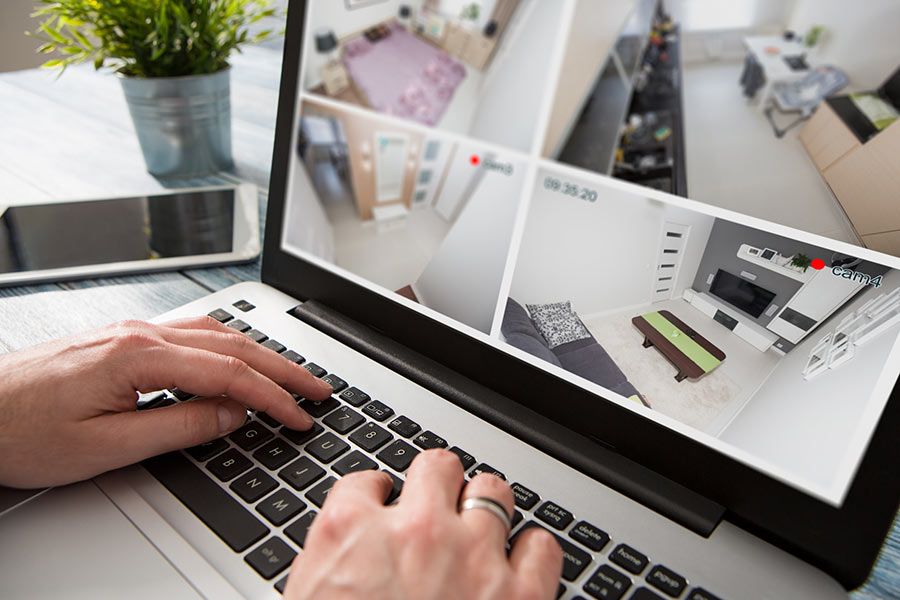In 2020-21 approximately 169,000 homes were broken into in New Zealand, which also saw a significant increase to 63% of repeat burglaries [1]. When it comes to deterring burglars, it pays to be vigilant as most intruders will look for easy entry points that are low-impact and offer a quick and convenient get away, such as a low-level unlocked window or door.
ADT has a range of indoor and outdoor cameras that allow you to monitor every area of the home with your specific security needs in mind.
Home security camera placement – outdoor areas
Outdoor security cameras are a home’s first line of defence. Whether your intention is to deter burglars from attempting a break-in or to monitor your property for movement while you’re away, these security camera placement tips will have you covered.
- Survey the entire perimeter of your property, taking note of the crawl spaces, entry points, hiding spots and assets at risk.
- Consider the number of cameras required by identifying visible locations that will act as a ‘deterrent’ to would-be burglars while ensuring they can be adequately viewed should footage of a break-in need to be assessed for identification purposes.
- Don’t overlook non-conventional entry points, as a burglar may avoid front doors and large windows in favour of an upper-level balcony or awning as alternate opportunities to gain entry.
- Strategically positioned cameras that offer an elevated vantage point can maximise coverage across an entire yard or down the side of a house.
- Protect your other assets by installing security cameras to monitor pools, garages, driveways, sheds and carports.
Home security camera placement – indoor areas
Indoor cameras can play an important role in supporting a home security system as well as provide homeowners with added lifestyle benefits by monitor indoor movement. They can not only be used to identify burglars, but can also let you check in with your family, pets or contractors through a live 24/7 feed while you’re away.
Here are some tips to help you get the most out of indoor security cameras.
- Monitor potential ‘hot spots’ where burglars are likely to gravitate towards, such as liquor cabinets, home offices, trophy/displays, jewellery boxes, etc.
- Consider placing cameras in common areas that provide opportunities to monitor pets or check in on family members. Some households may also wish to keep an eye on vulnerable occupants who may be elderly or have limited mobility by monitoring areas such as stairs.
- Visible cameras inside the home can also be a powerful deterrent should a burglar gain entry to a home, by alerting them that they are under surveillance. Indoor cameras can be placed in entrance foyers, hallways and other visible areas.
- Positioning cameras up high on shelves or tall furniture will not only protect them from interference but can also widen the field of view.
Camera placement guidelines & privacy considerations
The Privacy Commissioner states that the Privacy Act 2020 does not apply to those who set up security cameras at home if they are acting in a personal capacity [2]. There are, however, a narrow set of circumstances where the collection, use and disclosure would be highly offensive to a reasonable person, but footage is rarely considered offensive or sensitive if it could be seen from the street. Highly sensitive images include the intimate recording of people without their consent or knowledge and the publication of such recordings. Therefore, your security system could be subject to the Crimes Act if it is deemed to be spying on neighbours and infringing on their privacy.
It is important to be ethical and courteous to neighbours, ensuring that your security system is installed to protect you and your loved ones without making your neighbours feel unsafe. Installing security should include the following steps:
- Talk to your neighbours about your setup and intentions
- Put up signs telling people that cameras are in use
- Cooperate with your neighbours if they ask for footage
- Consider others before uploading footage to the internet
- Give your footage to Police if you suspect an offence has taken place
- Don’t point a security camera directly at a neighbour’s property, doors or windows.
- Don’t record activities that would otherwise be private
- Be responsible and ethical with footage – don’t keep footage for too long and don’t distribute footage of your neighbours on their property.
For more security tips and solutions, visit our website www.adtsecurity.co.nz or call us on 0800 111 238 for further advice from our team of licenced professionals.
1 https://www.justice.govt.nz/assets/Documents/Publications/Cycle-4-Core-Report-v0.20-20220628.pdf
2 https://www.privacy.org.nz/resources-2/privacy-and-cctv/#home




